Alerta
Alertas
Tipo de práctica
A pie
En bicicleta
Presentación
Mapa
Puntos de interés
Resumen de Cirkwi
Calificaciones y reseñas
Ver alrededor
Exposición universal de 1878


Crédito : Musée carnavalet
El resumen de Cirkwi
Descubre el Corazón de París: Un Viaje a través de la Exposición Universal de 1878
Siguiendo los pasos de la Exposición Universal de 1878, este cautivador viaje te invita a explorar el París histórico y Courbevoie, presentado por la mente imaginativa de Balades Fluviales Fabienne Lemoine Fondateur. Sumérgete en una narrativa que se remonta a un evento crucial en la historia parisina, donde la innovación y la belleza se encontraron a una escala sin precedentes. Embárcate en un paseo tranquilo por los lugares emblemáticos que hacen eco de la grandeza del pasado, experimentando la esencia de París junto a vestigios que resistieron el paso del tiempo. Esta aventura promete más que un simple tour; es un portal hacia el pasado, meticulosamente elaborado para los curiosos y los soñadores.
Detalles Técnicos del Itinerario Esencial
Este itinerario abarca una distancia total de aproximadamente 10.78 km, con un rango de elevación que te llevará desde los 24 metros en el punto más bajo hasta los 65 metros en su punto más alto. Te enfrentarás a un viaje suave y ondulante, con un cambio total de altitud positiva entre 153 y 143 metros. La ruta designada es principalmente amigable para peatones, lo que la convierte en un camino ideal para aquellos que disfrutan del placer de caminar. Perfectamente adecuado para una exploración de un día, presenta una aventura accesible para participantes de diversos niveles de condición física, ofreciendo una mezcla de vistas panorámicas y conocimiento histórico.
Consejos Estacionales para Exploradores
Para maximizar tu experiencia, la clave es vestirse según la ocasión y la estación. La primavera y el otoño en París ofrecen temperaturas suaves ideales para paseos extensos, mientras que el calor del verano permite un ritmo más relajado con muchas pausas a la sombra. Los inviernos, aunque más fríos, aún tienen su encanto con menos multitudes; solo asegúrate de llevar capas de ropa. Independientemente de la temporada, los zapatos cómodos para caminar son imprescindibles. En términos de seguridad, siempre mantente consciente de tu entorno, especialmente en zonas concurridas de la ciudad. Lleva agua, tal vez algo para picar, y deja que el clima del día guíe tu equipaje: protector solar para días soleados, chubasquero para las impredecibles lluvias parisinas.
París y Courbevoie: Un Tapiz Rico
Este viaje te lleva al corazón de París, una ciudad sinónimo de profundidad histórica y grandeza arquitectónica, y se extiende a Courbevoie, revelando diversas capas del patrimonio de la capital francesa. París, dentro de su diseño compacto, engloba sitios monumentales que han sido sede de diálogos globales significativos, como las grandiosas exposiciones. Courbevoie, a menudo eclipsada, sirve como un satélite histórico y cultural vital para la metrópolis. Esta región, que encapsula la esencia de los logros humanos y la expresión artística, es un testimonio de la resiliencia y la ingeniosidad del espíritu humano que se exhibieron durante la Exposición Universal de 1878.
Información sobre el Clima: Planifica tu Visita
El clima en París puede clasificarse ampliamente como templado, con estaciones distintas que ofrecen experiencias variadas. Los inviernos son fríos, con heladas ocasionales, mientras que los veranos pueden ser cálidos y a veces húmedos. La primavera y el otoño presentan el clima más agradable, caracterizado por temperaturas suaves y suaves brisas, perfecto para recorridos a pie. Dado este tableau climático, los momentos ideales para embarcarte en este viaje histórico son finales de la primavera (mayo a junio) y principios del otoño (septiembre a octubre), cuando las condiciones climáticas complementan hermosamente las exploraciones al aire libre, garantizando una experiencia cómoda y enriquecedora.
Siguiendo los pasos de la Exposición Universal de 1878, este cautivador viaje te invita a explorar el París histórico y Courbevoie, presentado por la mente imaginativa de Balades Fluviales Fabienne Lemoine Fondateur. Sumérgete en una narrativa que se remonta a un evento crucial en la historia parisina, donde la innovación y la belleza se encontraron a una escala sin precedentes. Embárcate en un paseo tranquilo por los lugares emblemáticos que hacen eco de la grandeza del pasado, experimentando la esencia de París junto a vestigios que resistieron el paso del tiempo. Esta aventura promete más que un simple tour; es un portal hacia el pasado, meticulosamente elaborado para los curiosos y los soñadores.
Detalles Técnicos del Itinerario Esencial
Este itinerario abarca una distancia total de aproximadamente 10.78 km, con un rango de elevación que te llevará desde los 24 metros en el punto más bajo hasta los 65 metros en su punto más alto. Te enfrentarás a un viaje suave y ondulante, con un cambio total de altitud positiva entre 153 y 143 metros. La ruta designada es principalmente amigable para peatones, lo que la convierte en un camino ideal para aquellos que disfrutan del placer de caminar. Perfectamente adecuado para una exploración de un día, presenta una aventura accesible para participantes de diversos niveles de condición física, ofreciendo una mezcla de vistas panorámicas y conocimiento histórico.
Consejos Estacionales para Exploradores
Para maximizar tu experiencia, la clave es vestirse según la ocasión y la estación. La primavera y el otoño en París ofrecen temperaturas suaves ideales para paseos extensos, mientras que el calor del verano permite un ritmo más relajado con muchas pausas a la sombra. Los inviernos, aunque más fríos, aún tienen su encanto con menos multitudes; solo asegúrate de llevar capas de ropa. Independientemente de la temporada, los zapatos cómodos para caminar son imprescindibles. En términos de seguridad, siempre mantente consciente de tu entorno, especialmente en zonas concurridas de la ciudad. Lleva agua, tal vez algo para picar, y deja que el clima del día guíe tu equipaje: protector solar para días soleados, chubasquero para las impredecibles lluvias parisinas.
París y Courbevoie: Un Tapiz Rico
Este viaje te lleva al corazón de París, una ciudad sinónimo de profundidad histórica y grandeza arquitectónica, y se extiende a Courbevoie, revelando diversas capas del patrimonio de la capital francesa. París, dentro de su diseño compacto, engloba sitios monumentales que han sido sede de diálogos globales significativos, como las grandiosas exposiciones. Courbevoie, a menudo eclipsada, sirve como un satélite histórico y cultural vital para la metrópolis. Esta región, que encapsula la esencia de los logros humanos y la expresión artística, es un testimonio de la resiliencia y la ingeniosidad del espíritu humano que se exhibieron durante la Exposición Universal de 1878.
Información sobre el Clima: Planifica tu Visita
El clima en París puede clasificarse ampliamente como templado, con estaciones distintas que ofrecen experiencias variadas. Los inviernos son fríos, con heladas ocasionales, mientras que los veranos pueden ser cálidos y a veces húmedos. La primavera y el otoño presentan el clima más agradable, caracterizado por temperaturas suaves y suaves brisas, perfecto para recorridos a pie. Dado este tableau climático, los momentos ideales para embarcarte en este viaje histórico son finales de la primavera (mayo a junio) y principios del otoño (septiembre a octubre), cuando las condiciones climáticas complementan hermosamente las exploraciones al aire libre, garantizando una experiencia cómoda y enriquecedora.
Generado automáticamente.
IGN tarjetas
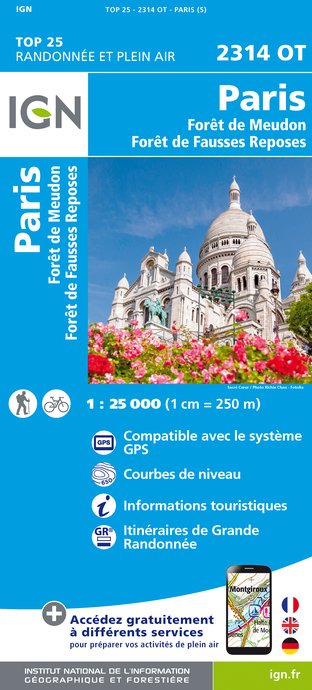
2314OT - PARIS FORÊT DE MEUDON FORÊT DE FAUSSES REPOSES
Editora : IGN
Recopilación : TOP 25 ET SÉRIE BLEUE
Escalera : 1:25 000
13.90€

190 PARIS CHANTILLY FONTAINEBLEAU
Editora : IGN
Recopilación : TOP 100
Escalera : 1:100 000
8.40€

118 PARIS CHARTRES PNR DE LA HAUTE VALLÉE DE CHEVREUSE
Editora : IGN
Recopilación : TOP 100
Escalera : 1:100 000
8.40€
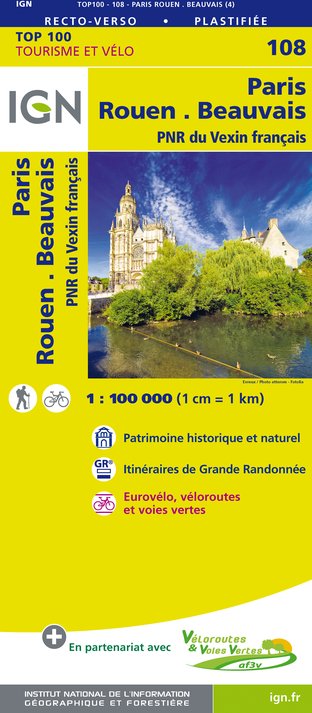
108 PARIS ROUEN BEAUVAIS PNR DU VEXIN FRANÇAIS
Editora : IGN
Recopilación : TOP 100
Escalera : 1:100 000
8.40€
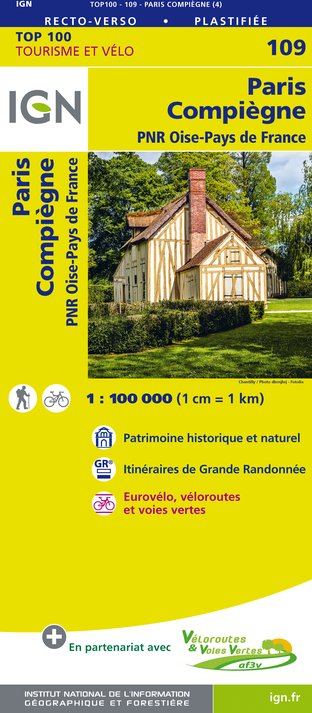
109 PARIS COMPIÈGNE PNR OISE-PAYS DE FRANCE
Editora : IGN
Recopilación : TOP 100
Escalera : 1:100 000
8.40€
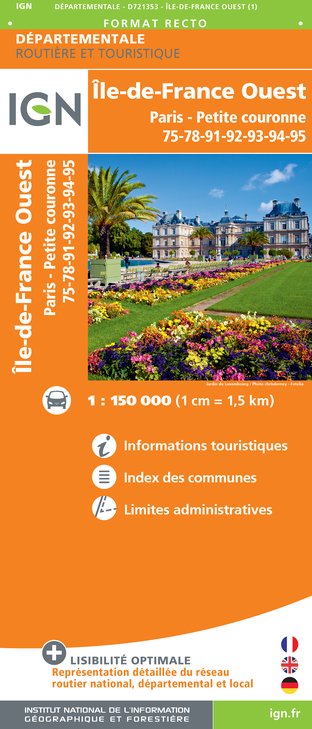
D75-95 ÎLE-DE-FRANCE OUEST
Editora : IGN
Recopilación : CARTES DÉPARTEMENTALES IGN
Escalera : 1:150 000
5.90€

D77 SEINE-ET-MARNE
Editora : IGN
Recopilación : CARTES DÉPARTEMENTALES IGN
Escalera : 1:150 000
5.90€

D28 EURE-ET-LOIR
Editora : IGN
Recopilación : CARTES DÉPARTEMENTALES IGN
Escalera : 1:150 000
5.90€

NR01 HAUTS-DE-FRANCE
Editora : IGN
Recopilación : CARTES RÉGIONALES IGN
Escalera : 1:250 000
6.80€

NR08 CENTRE-VAL DE LOIRE
Editora : IGN
Recopilación : CARTES RÉGIONALES IGN
Escalera : 1:250 000
6.80€

NR03 ÍLE DE FRANCE
Editora : IGN
Recopilación : CARTES RÉGIONALES IGN
Escalera : 1:250 000
6.80€
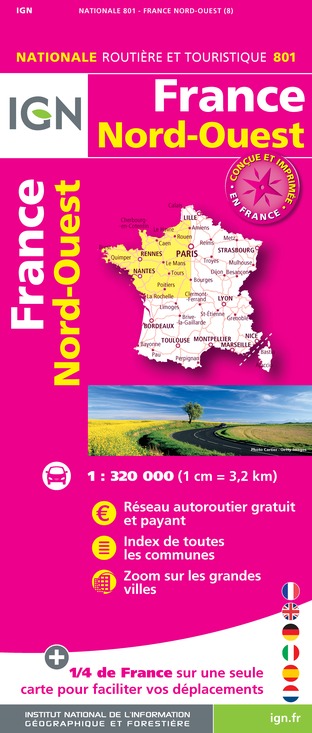
801 FRANCE NORD OUEST
Editora : IGN
Recopilación : CARTES NATIONALES IGN
Escalera : 1:320 000
6.10€

EUROPE
Editora : IGN
Recopilación : DÉCOUVERTE DES PAYS DU MONDE IGN
Escalera : 1:2 500 000
7.00€
Informaciónes técnicas
A pie
Dificultad
No especificada
Dist.
11 km
Tipo de práctica
A pie
En bicicleta
Mostrar más
Perfil altimétrico
Punto de partida
75007
Paris
Lat : 48.86047Lng : 2.32498
Puntos de interés
Autor de los datos
Calificaciones y reseñas
Para ver alrededor







